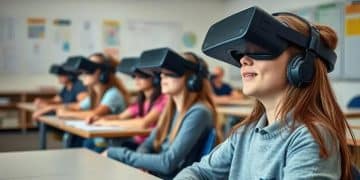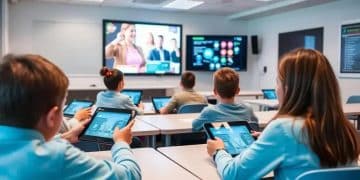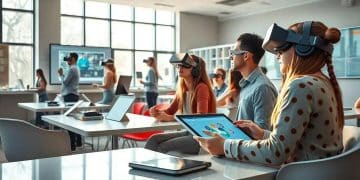Virtual lab simulations trends: what you need to know

Virtual lab simulations enhance education by providing interactive, accessible, and engaging environments where students can conduct experiments, collaborate remotely, and personalize their learning experiences through advanced technology.
Virtual lab simulations trends are gaining traction in the educational landscape, transforming how practical skills are developed. Have you ever imagined conducting experiments without the constraints of a traditional lab? Let’s dive into how these trends are impacting learning outcomes.
Understanding virtual lab simulations
Understanding virtual lab simulations is essential for embracing modern education. These digital platforms allow students to engage in hands-on experiments without the limitations of a physical lab. Imagine learning complex scientific concepts in a safe environment where mistakes can be made and corrected easily.
What are virtual lab simulations?
Virtual lab simulations replicate real-world lab experiences through computer software. Students can conduct experiments, investigate variables, and analyze data in a simulated setting. This approach caters to different learning styles, making it accessible for everyone.
Advantages of virtual lab simulations
- Flexibility to learn at one’s own pace.
- Reduced costs compared to maintaining physical labs.
- Safe environment for conducting risky experiments.
- Immediate feedback and analytics to enhance learning.
Utilizing virtual lab simulations provides an engaging alternative to traditional methods. Students can experiment freely, fostering creativity and critical thinking skills. They promote collaboration as students can work together in virtual teams, making science and technology education more interactive.
Moreover, these simulations offer opportunities for remote learning, essential in today’s world. Students from various backgrounds can access quality education, leveling the playing field for aspiring scientists and technologists.
As educational technologies evolve, the role of virtual lab simulations will become even more significant. They are not just beneficial for science classes but can extend to fields like engineering and business studies, where practical applications are crucial.
In summary, understanding virtual lab simulations allows educators and students to leverage these tools for enhanced learning experiences. It’s a promising avenue for modern education, integrating essential skills required for the future.
Key trends shaping the industry
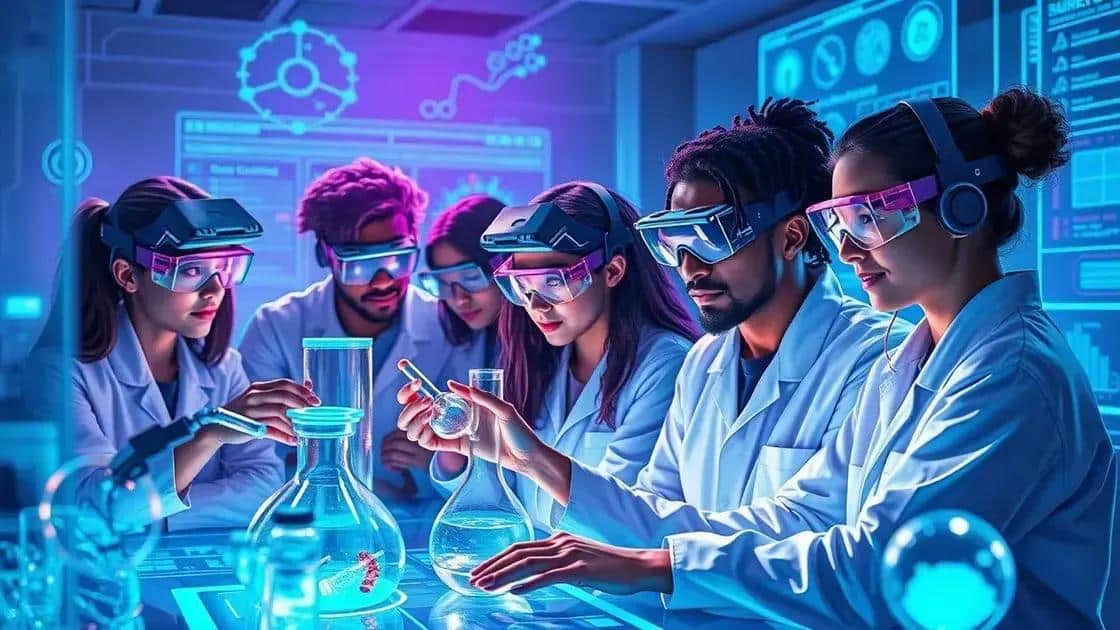
Key trends are shaping the virtual lab simulations industry, making it an exciting field to watch. Innovations in technology and educational practices are continuously transforming how students learn and interact with science.
Increased adoption of artificial intelligence
AI is enhancing virtual lab simulations by personalizing learning experiences. These systems can tailor content based on a student’s strengths and weaknesses. As AI technology evolves, we can expect even more sophisticated simulations, adapting to various learning styles.
Growing focus on accessibility
Accessibility is another major trend. As more educational institutions recognize the importance of inclusivity, developers are creating simulations that cater to students with disabilities. This focus ensures that all learners can participate in virtual labs, fostering a more equitable educational environment.
- Integration of voice recognition for hands-free navigation.
- Visual aids for students with hearing impairments.
- Customizable features to suit individual learning needs.
Another significant trend is the emphasis on collaborative learning. Virtual lab simulations are fostering teamwork by allowing students to work together, even from different locations. This rise in collaboration not only enhances learning but also prepares students for future careers where teamwork is essential.
Furthermore, the use of gamification is making virtual labs more engaging. Integrating game-like elements encourages student participation and motivation. This approach transforms routine tasks into interactive experiences, driving interest and excitement in science education.
As technology advances, we can expect the virtual lab simulations industry to continue evolving. Various sectors, including healthcare, environmental science, and engineering, are likely to benefit from these trends. Embracing these changes will not only improve educational outcomes but also prepare students for the challenges of tomorrow.
Benefits of using virtual labs in education
The benefits of using virtual labs in education are numerous and profound. These digital platforms allow students to engage in scientific experiments without the limitations of physical classrooms. This flexibility enables a richer learning experience that can be tailored to individual needs.
Enhanced engagement and interactivity
One major benefit is the increased engagement students experience with virtual labs. These simulations often use interactive elements that capture students’ attention. Rather than passively listening to lectures, learners can actively participate in experiments, which fosters a deeper understanding of concepts.
Access to diverse resources
Virtual labs provide access to a wide range of resources and tools that may not be available in a traditional classroom. Students can experiment with advanced equipment and software, gaining hands-on experience that would otherwise be impossible.
- Access to high-tech simulations of complex experiments.
- Availability of a wider variety of materials and resources.
- Opportunities to practice rare or expensive experiments safely.
Another significant advantage is the capacity for personalized learning. With virtual labs, learners can progress at their own pace, revisiting challenging concepts or accelerating through familiar material. This adaptability caters to individual learning styles, making education more effective for diverse learners.
Additionally, virtual labs can be repeated easily, allowing students to practice and learn from their mistakes. This repetition builds confidence and mastery in scientific concepts. It’s a safe space to explore without the fear of failure that often comes with real-life experiments.
Furthermore, the collaboration opportunities provided by virtual labs cannot be overlooked. Students from different locations can work together in real-time, sharing ideas and strategies. This aspect encourages teamwork and problem-solving skills that are essential for future careers.
Ultimately, the integration of virtual labs in education is revolutionizing how students learn. By harnessing technology to create engaging, accessible, and versatile learning environments, educators are preparing students for the demands of the modern world.
Future predictions for virtual lab technologies
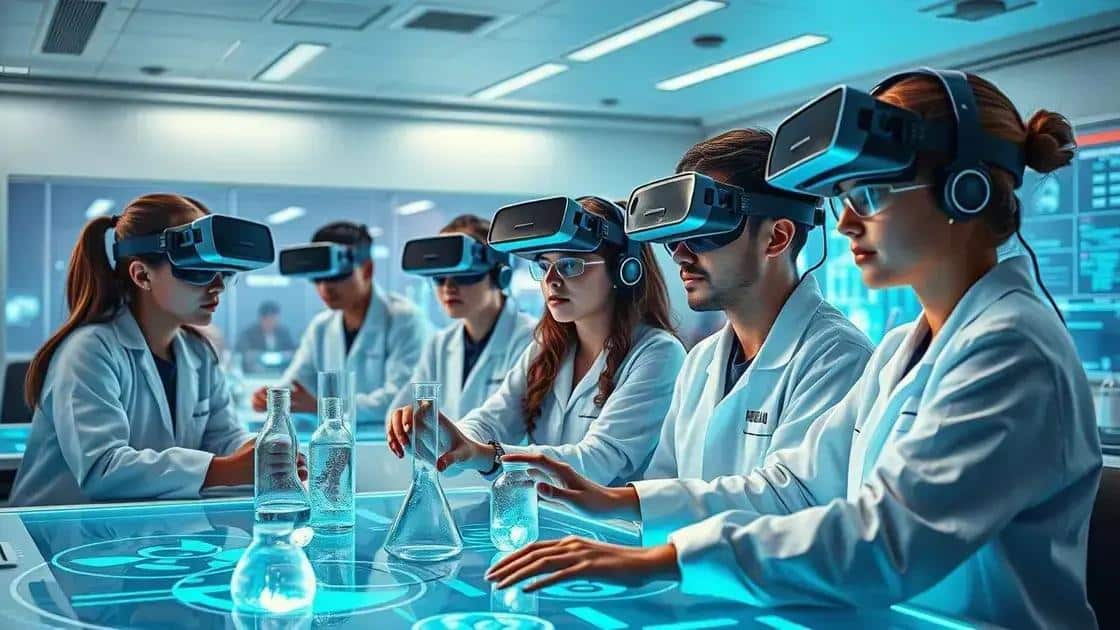
Future predictions for virtual lab technologies suggest remarkable developments in how students and professionals will engage with scientific learning. The landscape of education is evolving rapidly, and these changes will continue to enhance the learning experience.
Advancements in technology
One major prediction is the integration of more advanced technologies. Innovations in artificial intelligence and virtual reality are expected to make virtual labs even more immersive. Students will be able to conduct experiments in realistic environments, improving their understanding of complex scientific concepts.
Increased accessibility and personalization
As technology progresses, accessibility will also improve. More students, including those with disabilities, will have the opportunity to engage in virtual labs. Personalization of learning experiences will become a norm, allowing each student to learn at their own pace while receiving tailored feedback.
- Adaptive learning technologies that respond to individual needs.
- Remote accessibility for students across various locations.
- Integration of multiple languages and cultural contexts in learning materials.
Additionally, the importance of collaborative learning will grow. Future virtual lab technologies could incorporate features that allow students from different parts of the world to work together seamlessly. This collaboration will foster critical skills needed for the global workforce.
Moreover, the rise of gamification in education is predicted to enhance student motivation. Interactive elements such as challenges and rewards will be integrated into virtual labs, making learning more engaging and enjoyable. As a result, students will be more likely to participate actively and retain information.
Furthermore, partnerships between educational institutions and industry leaders are expected to strengthen. This collaboration will ensure that virtual lab technologies remain relevant and up-to-date with the latest scientific techniques and tools.
In summary, the future of virtual lab technologies holds great promise for enriching education. With advancements in technology, more personalized and accessible learning experiences will empower students to explore the wonders of science like never before.
In conclusion, the future of virtual lab technologies is bright and full of potential. As these tools evolve, they will provide students with more engaging, accessible, and personalized learning experiences. With advancements in technology, we can expect these virtual environments to enhance scientific education significantly. By embracing these trends, educators can better prepare students for future challenges in a constantly changing world. The journey of learning through virtual labs will open doors to new possibilities and knowledge for generations to come.
FAQ – Frequently Asked Questions about Virtual Lab Technologies
What are virtual lab technologies?
Virtual lab technologies are digital platforms that allow students to conduct experiments and simulations online, providing a hands-on learning experience.
How do virtual labs enhance student engagement?
Virtual labs use interactive elements to captivate students, allowing them to participate actively in experiments rather than passively absorbing information.
Are virtual labs accessible to all students?
Yes, virtual labs are designed to be accessible to a wide range of students, including those with disabilities, promoting inclusive education.
What role does collaboration play in virtual labs?
Collaboration in virtual labs encourages teamwork, as students can work together remotely on experiments, improving their communication and problem-solving skills.
